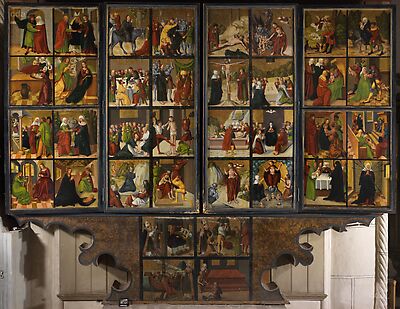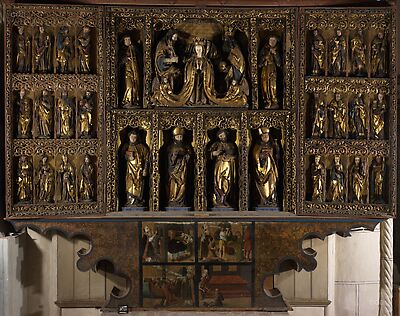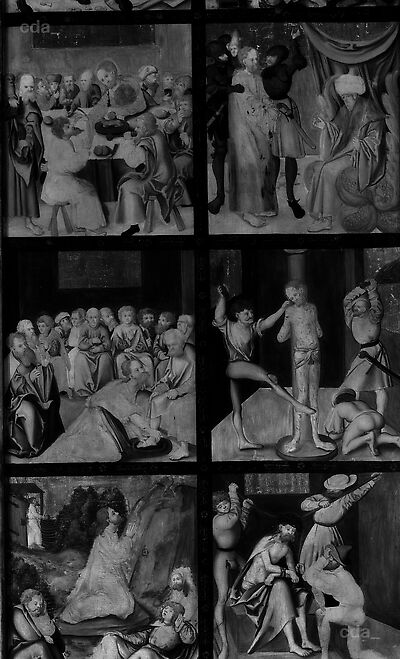Left inner wing, verso: Christ entering Jerusalem; the Last supper; The Washing of the Feet; Agony in the Garden; The Arrest of Christ; Christ before Pilate; The Flagellation; The Crowning of Thorns and The Mocking of Christ.
The Passion cycle on the central panels in front of the shrine begins
Left inner wing, verso: Christ entering Jerusalem; the Last supper; The Washing of the Feet; Agony in the Garden; The Arrest of Christ; Christ before Pilate; The Flagellation; The Crowning of Thorns and The Mocking of Christ.
The Passion cycle on the central panels in front of the shrine begins with an event described in all four gospels. The public recognize Jesus as the anointed of God. They hail him and spread out their clothes [...]. The artist shows Jesus on a donkey so large and so close to the picture plane that he occupies almost the entire pictorial space. The crowd behind is represented by only three people. One of them spreads out his coat. A large tree occupies the background, but the location is not further defined.
Second scene: The apostles sit around a square table, that is set with bread and the lamb in a bowl. [...] Christ is emphasised by depicting him larger in scale and St John is shown sleeping and resting his head on Christ's chest, a motif taken from the Gospel of St John 13, 23. Christ stretches over the table to offer Judas something to eat and as such identifies him as the one who will betray him as recounted in the Gospel of St John 13, 23-26. The traitor is identified by his red hair and his yellow gown. Yellow was considered a disreputable colour in the Middle Ages. He hides the bag of coins he received for his treachery behind his back. Another apostle sits drinking at the front edge to create a classic triangular composition. A young man stands at the left edge of the composition and pours wine into a chalice, while the others shown considerably smaller in scale watch the awful event unfold.
Third scene: Jesus kneels before Peter and washes his feet. The disciples watch the event like an audience at the theatre. Only St John's Gospel 13, 1-15 describes this event, which is based on an ancient Near East custom. Slaves usually undertook the washing [...]. For this reason Peter refused to have his feet washed until Christ explained: 'If I do not wash your feet you will no longer be my disciple'. This act of humiliation should set an example for the disciples who should wash one another's feet and also gave expression to his message, 'to love each other as I have loved you.'
Fourth scene: After the Last Supper Christ went with his disciples to the garden of Gethsemane. According to the Gospel of Matthew 26, 36-46 and Mark 14, 32-42 he left his disciples at the entrance to the garden, only Peter, John and James entered with him. The panel shows the three sleeping disciples, the blond curly headed John is in a deep child-like sleep and leans against James. Peter has put his knife on the ground and is almost overcome by sleep, while Jesus kneels on a slab of rock and prays with his hands outstretched that the cup will pass by him. This is represented on a high rocky outcrop as a symbol of God's anger [...]. In the background the wattle fencing surrounding the garden is visible behind the trees. The covered entrance is open, Judas enters and is followed by the soldiers in armour with lances.
Fifth scene: The panel depicts the moment when the troop reaches Christ, who is prepared. Judas embraces and kisses him as a sign of identification. The first of the temple guards grabs at him with his visor down and the torch bearer, illuminating the nocturnal scene, grabs his gown. Christ does not resist. In his right hand he holds the ear of Malcus that was cut off by Peter with his sword to reattach it to the soldier who now lies on the ground. The lantern, that has become symbolic for the nocturnal scene was knocked to the ground by Malcus as he fell.
Sixth scene: The bound Christ is lead before the Roman Procurator by soldiers and accused of political treachery in order to bring about the shameful death sentence by crucifixion. As Jews were not permitted to enter the pagan house of Justice, Pilate receives the accusation in front of his house. A green curtain is stretched out behind his throne. Pilate is dressed in a renaissance cloak with a broad fur collar and oriental turban and sits on an imaginatively decorated chair consisting of numerous burst pomegranates [...]. The original design may have been created by combining different elements from Cranach's graphic works.
Seventh scene: According to Roman law flagellation was an act of legal enforcement whereby the sentence was confirmed and the crucifixion was initiated. Here two henchmen hit the naked Christ, who is bound to a column, with rods rather than a whip.[...] A third rogue kneels on the ground to make the crown of thorns - not visible here. With this scene that of the humiliation or mocking of Christ is announced and prepared.
Eighth scene: A purple cloak has been placed on Christ's shoulders. He is bound and sits on a platform. His body displays the bloody wounds inflicted by the flagellation. Two henchmen press a crown made of thorny branches on his head with a long stick. A third man kneels before him and pulls at his hat while mockingly offering him a dry stick as a scepter. The henchmen execute their awful deed with detachment as if it were any job. The childlike face of the man on the left is turned towards the viewer with an expression almost of pity. The event appears frozen and the henchmen provide a frame for the reposed figure of majestic and yield acceptance.
[Sachs 1989, 51-67]
recto: carved figures
- Attributions
-
Follower of Lucas Cranach the Elder
Anonymous Master from the Cranach Workshop
Attributions
| Follower of Lucas Cranach the Elder | [Sachs 1989] |
| Anonymous Master from the Cranach Workshop | 'unknown, formal member of the Cranach Workshop' |
- Production date
- about 1515-1519
Production date
| about 1515-1519 | [cda 2017] |
- Dimensions
- Dimensions including frame: 282 x 128.5 cm
Dimensions
Dimensions including frame: 282 x 128.5 cm
[Heydenreich, cda 2016]
- Signature / Dating
None
- Owner
- St. Marien zu Bernau
- Repository
- St. Marien zu Bernau
- Location
- Bernau bei Berlin
- CDA ID
- DE_StMB_NONE-001a
- FR (1978) Nr.
- FR-none
- Persistent Link
- https://lucascranach.org/en/DE_StMB_NONE-001a/
![The Bernau Altarpiece [left inner wing]: Passion of Christ [verso]](https://lucascranach.org/imageserver-2022/DE_StMB_NONE-001a_FR-none/01_Overall/DE_StMB_NONE-001a_FR-none_2016-02_Overall-s.jpg)
![The Bernau Altarpiece [right inner wing]: Passion of Christ [verso]](https://lucascranach.org/imageserver-2022/DE_StMB_NONE-001b_FR-none/01_Overall/DE_StMB_NONE-001b_FR-none_2016-02_Overall-s.jpg)
![The Bernau Altarpiece [left alteration wing]: Live of the Virgin [recto], Live of Saints [verso]](https://lucascranach.org/imageserver-2022/DE_StMB_NONE-001c_FR-none/01_Overall/DE_StMB_NONE-001c_FR-none_2016-02_Overall-s.jpg)
![The Bernau Altarpiece [right alteration wing]: The childhood of Christ [recto], Live of Saints [verso]](https://lucascranach.org/imageserver-2022/DE_StMB_NONE-001d_FR-none/01_Overall/DE_StMB_NONE-001d_FR-none_2016-02_Overall-s.jpg)
![The Bernau Altarpiece [left side wing]: The Golden Legend (Aurea Legenda)](https://lucascranach.org/imageserver-2022/DE_StMB_NONE-001e_FR-none/01_Overall/DE_StMB_NONE-001e_FR-none_2016-02_Overall-s.jpg)
![The Bernau Altarpiece [right side wing]: The Golden Legend (Aurea Legenda)](https://lucascranach.org/imageserver-2022/DE_StMB_NONE-001f_FR-none/01_Overall/DE_StMB_NONE-001f_FR-none_2016-02_Overall-s.jpg)
![The Bernau Altarpiece [predella]: St Nicholas legend](https://lucascranach.org/imageserver-2022/DE_StMB_NONE-001g_FR-none/01_Overall/DE_StMB_NONE-001g_FR-none_2016-02_Overall-s.jpg)


